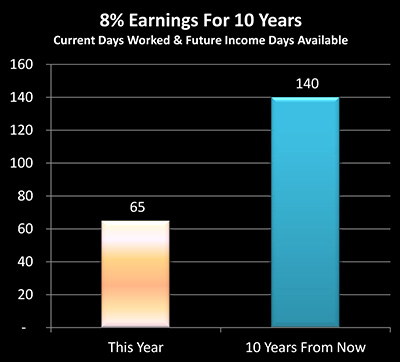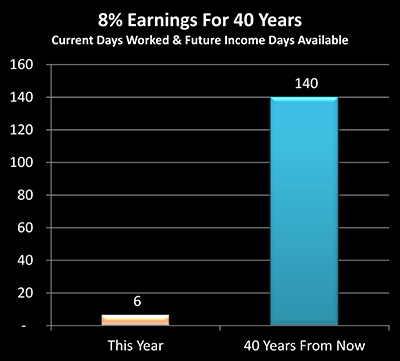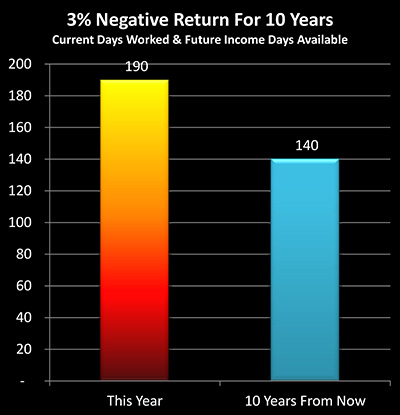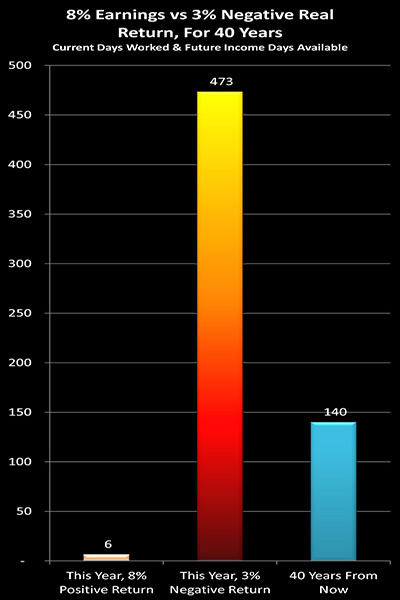Conflicts Of Interest Between Governments & Retirement Investors
Stock-Markets / Investing 2015 Mar 16, 2015 - 04:55 PM GMTBy: Dan_Amerman
 Most retirement account and other long term investors continue to follow the same financial strategies they've been following for decades, believing that the "science" of modern finance will reliably build wealth and security for them.
Most retirement account and other long term investors continue to follow the same financial strategies they've been following for decades, believing that the "science" of modern finance will reliably build wealth and security for them.
Meanwhile, for some years now and as a matter of openly stated policy, the Federal Reserve, European Central Bank and Bank of Japan, as well as the central banks of other nations have sought to create what are known as "negative real rates of return".
What needs to be understood is that there are four direct conflicts of interest between current government policies and the most widely followed retirement investment strategies. Indeed, the purpose of massive monetary interventions around the world is to override the usual market forces, in order to meet governmental goals.
Unfortunately, what is being overridden are the same market forces which traditional financial planning is dependent upon. And as a result, the projected wealth assumptions built into traditional financial planning models can become completely invalid.
Simply put, the basis of conventional financial planning is to use time and money to create wealth. What is baked into the heart of the assumptions, and what drives the financial planning models, is that time builds wealth, and the more time we have to work with, then the more wealth that is created and the greater the eventual financial security.
The problem is that when we take this currently very low interest rate environment which has been created by the governments, and we factor in the effects of even a low rate of inflation, then a potential inversion occurs – to the extent that time now destroys wealth, and the farther out in time we go, then the less financial security that we have.
As we will explore, governments have four powerful motivations to continue with the current policies into the indefinite future. For as it happens, what is a negative situation for traditional investors – is in fact a positive one for governments. This necessarily means there is a direct conflict of interest between those investors and governments, and potentially for the long term.
For those trying to build financial security, there are few things that are more dangerous than this total mismatch between 1) investing based upon the traditional assumptions from decades gone by, even while 2) in the real world the governments are currently pulling the rug out from under those assumptions as a matter of national policy.
In an effort to help correct this mismatch, we will use simple illustrated examples to show how current government policies can turn upside down everything we have been taught about how to reliably achieve financial security over time.
How Financial Planning Is Supposed To Work
According to the conventional model, this is how retirement investing is supposed to work:

Let's say we are investing for 10 years from today, and on top of our retirement benefits, we want to save more cash both for additional security and to have a better standard of living. If we want cash equal to 20 weeks, or 140 days of our current income, fortunately we don't actually have to save that much.
We could cover those 140 days of income in the future by setting aside 65 days of income today, and putting that money to work for us inside a tax-deferred retirement account. At an 8% return, this would generate enough income to cover another 75 days of our current income, which means that we more than doubled our money over those ten years.
That's pretty darn sweet, but it gets even better. As we have all heard, the sooner we start saving then the higher quality the retirement we will eventually have, because retirement investing is far more lucrative when we invest for longer periods of time.

For instance, let's say that we are 45, and we are investing to create financial security forty years into the future when we are age 85. Then according to the mathematics used inside of financial and retirement planning models – by assuming 8% yields each year on average, we only have to set aside 6 days of our current income in order to have 140 days of income available at that time.
That is so good as to be almost financial magic, and it is why we are urged to have retirement accounts such as IRAs and 401s and the like, and it is also why we are urged to start saving for retirement in our 20s and 30s if we can.
The Impact Of Very Low Yields
Unfortunately, however, that isn't how things have actually been working out in practice. Instead of high rates of return rapidly building wealth, we have the aforementioned "negative real interest rates" – and millions of retirees around the world are feeling the impact in their daily standard of living.
Now, interest rates don't actually have to literally be negative (although they indeed are in a few European countries right now). The same effect is achieved when earnings are less than the rate of inflation, as they have been in the United States for some years now. Because if the investment return doesn't keep up with the rate of inflation, then our savings become worth a little less in purchasing power terms each year – not a little more – thus giving us a negative return in terms of what our money will buy for us.
So how do our commonplace retirement plans for wealth creation hold up in a situation like our current one?
Let's assume we are earning an effectively 0% interest rate, like so many are these days, and inflation is about the historical average for the US since World War II, or around 3% per year. We have the same amount of money at the end of the year that we did when we started – but what that money will buy for us is worth less – indeed having fallen by 3%. This is what is meant by a "negative real return" (with "real" meaning inflation-adjusted) – and in this case it's negative 3%.
Another way of phrasing it is that there is 3% deflation on the value of our savings in purchasing power terms.

The above graph shows why "negative real returns" are far more dangerous for retirees and retirement investors than most people realize. For when we take even relatively low rates of inflation into account, then these very low yields don't produce the "magic" compounding of retirement savings. Instead, in fact, they reverse it.
So if we want the security of 140 days of our current income ten years from now, then we have to work to cover all 140 days now – and we then have to work another 50 days to cover the cumulative effects of the 3% annual loss of our money's purchasing power during each of the intervening years.
Now to understand the full extent of the problem, we need to look at the much more powerful impact it has if we're investing over longer time periods. Consider the following graph.

If we can rely upon those assumed 8% earnings working for us for forty years, then yes, working only six days this year can cover 140 days of income in the future.
However, if after adjusting for inflation we are instead losing just a little bit each year, and we look at what 3% losses working against us would do over forty years, we see that the "magic" is reversed. Instead of working six days this year to cover 140 days of income in the future, we would have to work 473 days. Which given that there are only 365 days in a year – becomes an impossible situation.
So it's not that investment yields beneath the rate of inflation only somewhat reduce the benefits of retirement savings plans – they don't lead to just a slight downward adjustment – but rather they completely collapse the very foundation of those plans.
A Deliberate & Possibly Long-Term Situation
It also needs to be understood that this toxic environment for savers is not an accident or happenstance, but has been deliberately created. In the United States we do have close to zero percent short term interest rates on our bank accounts, we do have inflation at a higher rate, and both components have been created by the Federal Reserve in the very open pursuit of "negative real interest rates" as a matter of economic policy.
The same toxic situation for retirement investors has been created by the European Central Bank in Europe, by the Bank of Japan in Japan, and by other central banks as well. Just read the daily financial headlines or the press releases, and most of the major nations in the world are quite openly and as a matter of policy trying to increase their rates of inflation even while they keep their interest rates at historically low levels.
This situation is so pervasive not because governments have some malicious goal of hurting savers – I don't believe that at all. It's rather that governments publicly share some practical and very compelling motivations for creating "negative real interest rates".
First, as explored here, many of the most prominent economists in the world, including people like Lawrence Summers and Paul Krugman, strongly and openly advocate these economic policies as being the best way to create economic growth and stimulate job creation. Crucially, what these economists fear and are attempting to fight is what is known as "secular stagnation", with "secular" meaning long term, i.e. ten years or more.
So if the problem could last for ten years or more, it's reasonable to anticipate that the attempted "cure" could last for ten years or more. And with that, the side effect of slashed standards of living for retirees relying on their investment income could last for many years. This could mean an extended reversal of financial planning projections, with wealth destruction replacing wealth creation inside of many retirement accounts, in inflation-adjusted terms.
There are other powerful advantages for governments when it comes to creating near zero interest rates along with somewhat higher rates of inflation, when we consider that the United States, Japan and most of Europe are all heavily indebted and with aging populations. As explored here, the lower the interest rate, the less the debt payments, and the lower the budget deficits. Let me suggest that this creates a long term and major direct conflict of interest between governments and savers.
When we understand this sharp conflict of interest between retirement investors and heavily indebted governments, then we can see that there are "two sides to the coin". One side of "negative real interest rates" is savers losing wealth over time – and the other side is governments actually taking that wealth and using it to reduce government debts (as explained here), in a manner that has been extensively used in the past, through a process which history shows most voters simply don't understand.
Of further crucial importance is that creating negative real interest rates makes owning a nation's currency undesirable, which makes the currency fall in value, which makes exports cheaper, and thereby creates a competitive advantage for exporting goods. Japan quite successfully used this strategy to slash the value of the yen, while boosting both employment and corporate profits. The Europeans are attempting the same thing, and other nations around the world are also cutting interest rates so as not be at a competitive disadvantage, and to hang on to the jobs they have.
In other words there is a current global competition of sorts, in which nations are competing to make their real (inflation-adjusted) interest rates more negative than other nations, in the attempt to gain price advantages on the goods they're selling, as they try to take economic growth and jobs from each other.
With the unfortunate side effect being that they are also essentially competing to see who can most effectively destroy retirement investor wealth creation within their own nations.
"Collateral Damage" & Our Future Financial Security
The 2nd part of this article explores:
1) Connecting three dots, and the integration of the four long term conflicts of interest;
2) The political cover for destroying retirement wealth without election consequences; and
3) Related resources for understanding and overcoming these challenges.
Daniel R. Amerman, CFA
Website: http://danielamerman.com/
E-mail: mail@the-great-retirement-experiment.com
Daniel R. Amerman, Chartered Financial Analyst with MBA and BSBA degrees in finance, is a former investment banker who developed sophisticated new financial products for institutional investors (in the 1980s), and was the author of McGraw-Hill's lead reference book on mortgage derivatives in the mid-1990s. An outspoken critic of the conventional wisdom about long-term investing and retirement planning, Mr. Amerman has spent more than a decade creating a radically different set of individual investor solutions designed to prosper in an environment of economic turmoil, broken government promises, repressive government taxation and collapsing conventional retirement portfolios
© 2015 Copyright Dan Amerman - All Rights Reserved
Disclaimer: This article contains the ideas and opinions of the author. It is a conceptual exploration of financial and general economic principles. As with any financial discussion of the future, there cannot be any absolute certainty. What this article does not contain is specific investment, legal, tax or any other form of professional advice. If specific advice is needed, it should be sought from an appropriate professional. Any liability, responsibility or warranty for the results of the application of principles contained in the article, website, readings, videos, DVDs, books and related materials, either directly or indirectly, are expressly disclaimed by the author.
© 2005-2022 http://www.MarketOracle.co.uk - The Market Oracle is a FREE Daily Financial Markets Analysis & Forecasting online publication.



